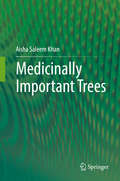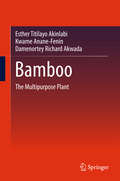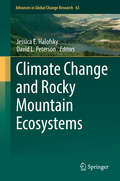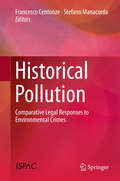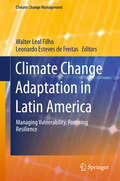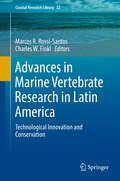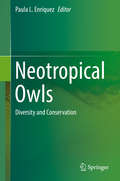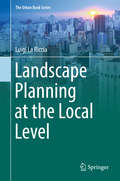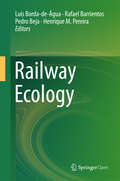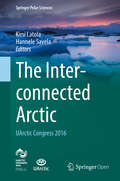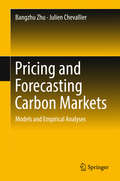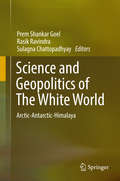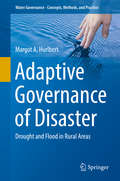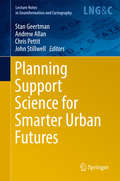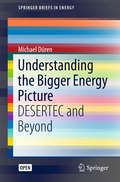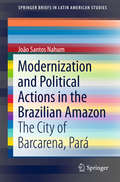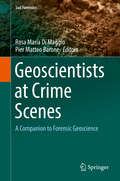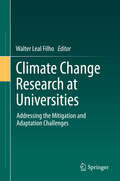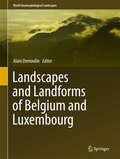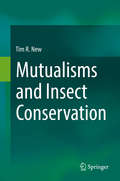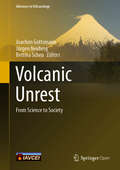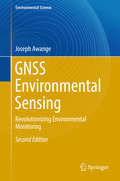- Table View
- List View
Medicinally Important Trees
by Aisha Saleem KhanThis book provides researchers and advanced students associated with plant and pharmaceutical sciences with comprehensive information on medicinal trees, including their identification, morphological characteristics, traditional and economic uses, along with the latest research on their medicinal compounds.The text covers the ecological distribution of over 150 trees, which are characterized mainly on the basis of their unique properties and phytochemicals of medicinal importance (i.e., anti-allergic, anti-diabetic, anti-carcinogenic, anti-microbial, and possible anti-HIV compounds). Due to the incredibly large diversity of medicinal trees, it is not possible to cover all within one publication, so trees with unique medicinal properties that are relatively more common in many countries are discussed here in order to make it most informative for a global audience.With over 100 illustrations taken at different stages of plant development, this reference work serves as a tool for tree identification and provides morphological explanations. It includes the latest botanical research, including biochemical advancements in phytochemistry techniques such as chromatographic and spectrometric techniques. In addition, the end of each chapter presents the most up-to-date references for further sources of exploration.
Bamboo: The Multipurpose Plant
by Esther Titilayo Akinlabi Kwame Anane-Fenin Damenortey Richard AkwadaThis book is intended for use both in the industry and the academia. It introduces the physical, chemical and the mechanical properties as well as the characterization of bamboo. Novel industrial applications in structural, non-structural, reinforcement, afforestation, land reclamation, environmental significance, textile, medical, geotechnical, hydraulic, food, pulp and the paper industries are addressed in detail.Bamboo has been used for centuries as a structural material as well as in diverse engineering applications, food and medicinal purposes, especially in Asia. As a natural fiber composite, bamboo has the potential for many developments in academic and industrial research. Current literature on composites tends to focus on bamboo as a plant or solely as a structural engineering material. This book seeks to bring together these two extremes and provides a holistic resource on the subject.
A Critical Review of Scottish Renewable and Low Carbon Energy Policy
by Geoffrey Wood Keith BakerThis book offers comprehensive coverage of current energy policy in Scotland focussing on non-fossil fuel energy options: renewables, nuclear power and energy efficiency. Covering issues of policy and practice, planning, legislation and regulation of a range of sustainable energy technologies in the context of devolved government, key experts explore these issues in terms of the ongoing Scottish independence debate, Brexit and further devolution in this vitally important and timely book.The book emphasises two further distinctive areas: constitutional change and the role of sub-national authorities in renewable and low carbon energy policy and practice. The clear focus on renewable and low carbon energy policy and practice and sub-national authority level of governance of energy means that it will be of particular relevance as a case study for those countries either in the process of deploying renewable and/or low carbon energy technologies or looking to do so. The authors discuss the many lessons to be learnt from the Scottish and UK experience.By providing a critical analysis of Scottish renewable and low carbon energy policy and practice, this book is invaluable to students, practitioners and decision-makers interested in renewable and low carbon energy transitions, energy planning and policy.
A Critical Review of Scottish Renewable and Low Carbon Energy Policy
by Geoffrey Wood Keith BakerThis book offers comprehensive coverage of current energy policy in Scotland focussing on non-fossil fuel energy options: renewables, nuclear power and energy efficiency. Covering issues of policy and practice, planning, legislation and regulation of a range of sustainable energy technologies in the context of devolved government, key experts explore these issues in terms of the ongoing Scottish independence debate, Brexit and further devolution in this vitally important and timely book.The book emphasises two further distinctive areas: constitutional change and the role of sub-national authorities in renewable and low carbon energy policy and practice. The clear focus on renewable and low carbon energy policy and practice and sub-national authority level of governance of energy means that it will be of particular relevance as a case study for those countries either in the process of deploying renewable and/or low carbon energy technologies or looking to do so. The authors discuss the many lessons to be learnt from the Scottish and UK experience.By providing a critical analysis of Scottish renewable and low carbon energy policy and practice, this book is invaluable to students, practitioners and decision-makers interested in renewable and low carbon energy transitions, energy planning and policy.
Climate Change and Rocky Mountain Ecosystems (Advances in Global Change Research #63)
by Jessica Halofsky David L. PetersonThis book is the result of a team of approximately 100 scientists and resource managers who worked together for two years to understand the effects of climatic variability and change on water resources, fisheries, forest vegetation, non-forest vegetation, wildlife, recreation, cultural resources and ecosystem services. Adaptation options, both strategic and tactical, were developed for each resource area. This information is now being applied in the northern rocky Mountains to ensure long-term sustainability in resource conditions.The volume chapters provide a technical assessment of the effects of climatic variability and change on natural and cultural resources, based on best available science, including new analyses obtained through modeling and synthesis of existing data. Each chapter also contains a summary of adaptation strategies (general) and tactics (on-the-ground actions) that have been developed by science-management teams.
Historical Pollution: Comparative Legal Responses to Environmental Crimes
by Francesco Centonze Stefano ManacordaThis volume examines legal matters regarding the prevention and fighting of historical pollution caused by industrial emissions. "Historical pollution" refers to the long-term or delayed onset effects of environmental crimes such as groundwater or soil pollution. Historical Pollution presents and compares national legal approaches, including the most interesting and effective mechanisms for managing environmental problems in relation with historical pollution. It features interdisciplinary and international comparisons of traditional and alternative justice mechanisms.This book will be of interest to researchers in criminology and criminal justice and related areas, such as politics, law, and economics, those in the public and private sectors dealing with environmental protection, including international institutions, corporations, specialized national agencies, those involved in the criminal justice system, and policymakers.
Climate Change Adaptation in Latin America: Managing Vulnerability, Fostering Resilience (Climate Change Management)
by Walter Leal Filho Leonardo Esteves de FreitasThis book showcases experiences from research, field projects and best practice in climate change adaptation in countries in the Latin American region, focusing on managing vulnerability and fostering resilience. It includes a selection of papers presented at a specialist symposium on climate change adaptation held in Rio de Janeiro, Brazil in November 2016.Consistent with the need for more cross-sectoral interaction among the various stakeholders working in the field of climate change adaptation in Latin America, the book documents and disseminates the wealth of experiences in the region. It is divided into two main parts: Part 1 addresses the current and future impacts of climate change on fauna, flora and landscapes, while Part 2 is concerned with the socio-economic aspects of climate change adaptation, analyzing some of the main problems prevailing in this vulnerable region and examining ways to address them.
Advances in Marine Vertebrate Research in Latin America: Technological Innovation and Conservation (Coastal Research Library #22)
by Marcos R. Rossi-Santos Charles W. FinklThis book gathers the most recent research findings on ecology and conservation of marine vertebrates in Latin America, making use of high technological methods to show readers the diversity of the marine research that has been conducted in these countries over the last decades. The book brings authors from more than 23 institutions of 7 different countries developing the most diverse research aiming at ocean conservation through the ecology of different vertebrate animals, such as whales, dolphins, manatees, turtles, seabirds and fish.This book deals with technological advances and innovation in the ecology and conservation of marine vertebrates in Latin America. This eclectic collection is broad in scope but provides detailed summaries of new methods that are deployed in the study of marine environmental conservation. Key issues revolve around the development and application of educational methodologies in the field of marine vertebrate research, which provide a rational basis for better management of marine environments using modern techniques associated with GIS, satellite tracking, aerial systems, bioacoustics, biogeochemistry, genetics, underwater videography, species photoidentification, molecular biology, trophic ecological methods, ethological methods, and behavioural ecology, among others. Discussion and elucidation of these kinds of techniques are aimed at university-level students and post-graduate researchers. The scope of this volume includes whales, sharks, rays, dolphins, tropical fishes, turtles, manatees as well as aspects of Latin American marine ecosystem conservation. Researchers in this biogeographic region, as well as others involved with marine vertebrate research, will find this work essential reading.
The Evolution of Flight
by Georg Glaeser Hannes F. Paulus Werner NachtigallThis book will take you on an exciting journey made up of texts and images. Spectacular, large-scale photographs printed on double pages and accompanied by explanatory texts will arouse the reader’s curiosity about evolution’s accomplishments in the world of flying: from the botanical air fleet (pollen grains, flying seeds…), over flying snakes and fish, to penguins flying underwater and humans rising into the air.Mathematician and passionate animal photographer Georg Glaser has joined forces with the experienced evolutionary biologist Hannes Paulus and the exercise physiologist and flight biophysicist Werner Nachtigall in order to approach this topic with words and pictures in a way that is both generally comprehensible and scientifically sound.Double-page by double-page, the book can be read in any order. Cross-references allow to jump easily from one double-page to another. Aside from the detailed introduction to each chapter, the text passages are usually independent from one another, and they discuss crucial moments in the evolutionary process. The double-pages provide additional information on bibliographical references and references to informative websites.
Neotropical Owls: Diversity and Conservation
by Paula L. EnriquezThis book presents a comprehensive biological and ecological information about owls in the neotropic area. In addition the book covers topics such as threats and conservation strategies for these nocturnal birds of prey from 18 Neotropical countries. Owls are a good example of diversification processes and have developed evolutionary characteristics themselves. These species are found almost everywhere in the world but most of them are distributed in tropical areas and about a third of them live in the Neotropics. This biogeographic region has a high biodiversity and even share lineages of species from other continents because at some point all were part of Pangea. Although we still have much to know and understand about this diverse, scarcely studied and threatened group this work aims to be a precedent for future and further research on the subject.
Landscape Planning at the Local Level (The Urban Book Series)
by Luigi La RicciaThe book, showing virtuous examples of urban planning in Italy and Europe, exposes certain doubts and open questions: what is the new role of urban planning? What actions / rules are now achievable for the protection, planning and management of local-scale landscapes? The overall reflections gathered in the book contribute to suggest innovative visions about landscape planning at local scale, seen as first steps towards a more functional change of perspective. New landscapes are the result of local planning practices that no longer seem able to “understand” the current society through urban design. Public space and new urban centralities interact with the increasingly complex functions of social life and mark the distance from territorial values, relying less and less on physical relationships (economic and functional) and increasingly on symbolic and intangible relationships, as ‘cultural identity’. Landscape is essential for the sustainable future of the urban and rural territory: the landscape quality is a factor of economic competitiveness and acts also as a factor of social cohesion and integration.
Railway Ecology
by Luís Borda-de-Água Rafael Barrientos Pedro Beja Henrique Miguel PereiraThis book is open access under a CC BY 4.0 license.This book provides a unique overview of the impacts of railways on biodiversity, integrating the existing knowledge on the ecological effects of railways on wildlife, identifying major knowledge gaps and research directions and presenting the emerging field of railway ecology. The book is divided into two major parts: Part one offers a general review of the major conceptual and theoretical principles of railway ecology. The chapters consider the impacts of railways on wildlife populations and concentrate on four major topics: mortality, barrier effects, species invasions and disturbances (ranging from noise to chemical pollution). Part two focuses on a number of case studies from Europe, Asia and North America written by an international group of experts.
The Interconnected Arctic — UArctic Congress 2016 (Springer Polar Sciences)
by Kirsi Latola Hannele SavelaThis open access book presents the most current research results and knowledge from five multidisciplinary themes: Vulnerability of Arctic Environments, Vulnerability of Arctic Societies, Local and Traditional Knowledge, Building Long-term Human Capacity, New Markets for the Arctic, including tourism and safety. The themes are those discussed at the first ever UArctic Congress Science Section, St. Petersburg, Russia, September 2016. The book looks at the Arctic from a holistic perspective; how the environment (both marine and terrestrial) and communities can adapt and manage the changes due to climate change. The chapters provide examples of the state-of-the-art research, bringing together both scientific and local knowledge to form a comprehensive and cohesive volume.Except where otherwise noted, this book is licensed under a Creative Commons Attribution 4.0 International License. To view a copy of this license, visit http://creativecommons.org/licenses/by/4.0/.
Pricing and Forecasting Carbon Markets: Models and Empirical Analyses
by Bangzhu Zhu Julien ChevallierThis book applies the multidisciplinary approaches of econometrics, statistics, finance and artificial intelligence for pricing and forecasting the carbon market in the context of managerial issues. It explores the related issues of pricing and forecasting the carbon market using theoretical models and empirical analyses, demonstrating how the carbon market, as a policy-based artificial market, is complex and influenced by both the market mechanisms and the external heterogeneous environments. By integrating the features of analytical systems, it offers insights to further our scientific understanding of the pricing mechanism and the variable laws governing the carbon market. Moreover, it lays a foundation for dealing with climate change in China and constructing a national carbon market there. Ultimately, it actively contributes to the energy saving and CO2 emission reduction promoted by the carbon market.The carbon market, represented by the European Union Emissions Trading System (EU ETS), is a cost-effective measure for tackling climate change. Furthermore, pricing and forecasting carbon market has been one of the research focuses in the fields of energy and climate change. As a policy tool of the trading mechanism, the carbon market offers a great institutional innovation for coping with climate change. Due to its multiple advantages including saving costs and environment protection, and political feasibility, more and more countries including China have applied the carbon market for carbon dioxide (CO2) emission reduction. Accurately understanding the pricing mechanism and mastering the fluctuating law of carbon market is essential to build a national carbon market for China.
Science and Geopolitics of The White World: Arctic-Antarctic-Himalaya (Society Of Earth Scientists Ser.)
by Prem Shankar Goel Rasik Ravindra Sulagna ChattopadhyayThis book brings together thirteen selected papers presented in the Third International Seminar on Science and Geopolitics of Arctic-Antarctic-Himalaya, held in India in September 2015. The papers and have been grouped according to the Seminar’s three main themes: a) Geopolitics of the Polar Regions, b) Global Climate Change and Polar Regions, and c) Climate Change and Himalayan Region.
Adaptive Governance of Disaster: Drought and Flood in Rural Areas (Water Governance - Concepts, Methods, and Practice)
by Margot A. HurlbertThis book provides a comparative analysis of policy instruments designed to respond to climate change, drought and floods in connection with agricultural producers and their communities in four case study areas: Alberta and Saskatchewan, Canada; Coquimbo, Chile; and Mendoza, Argentina. Assessed from the standpoint of effectiveness and adaptive governance, instruments for improving the livelihood capitals of agricultural producers are identified and recommendations to improve the suite of policy instruments are put forward.
Planning Support Science for Smarter Urban Futures (Lecture Notes in Geoinformation and Cartography)
by Stan Geertman Andrew Allan Chris Pettit John StillwellThis book offers a selection of the best articles presented at the CUPUM (Computers in Urban Planning and Urban Management) Conference, held in the second week of July 2017 at the University of South Australia in Adelaide.It provides a state-of-the-art overview of the availability and application of planning support systems (PSS) in the context of smart cities, big data, and urban futures. Rapid advances in computing, information, communication and web-based technologies are reaching into all facets of urban life, creating new and exciting urban futures. With the universal adoption of networked computing technologies, data generation is now so massive and all pervasive in society that it offers unprecedented technological solutions for planning and managing urban futures. These technologies are essential to effective urban planning and urban management in an increasingly challenging world, with socially disruptive changes, more complex and sophisticated urban lives and the need for resilience to deal with the possibility of adverse future environmental events and climate change. The book discusses examples of these technologies which encompass, inter alia: ‘smart urban futures’, where cities with myriad sensors are networked with communication technologies that enable the city planners to monitor well-being and be responsive to citizens' needs to allow dynamic management in real-time; PSS that encompass new hardware, develop new indicators, applications and innovative ways of facilitating public and community involvement in the management and planning of urban areas; and urban modelling that draws on theory and the richness of data from the growing range of urban sensing and communication technologies to build a better understanding of urban dynamics, trends and 'what-if' scenario investigations, and to provide better tools for planning and policymaking.
Understanding the Bigger Energy Picture: DESERTEC and Beyond (SpringerBriefs in Energy)
by Michael DürenThis book is open access under a CC BY 4.0 license.This book focuses on the global cycles of energy, water and carbon, which are not only the essentials of our main energy carriers, the fossil fuels, but are also the building blocks of life. The book offers an overview of the basic scientific facts and relationships that are needed to understand today’s energy generation and use, how they relate to global climate, the water cycle and other resources, and the complexities of energy policy. Building on the work of the Desertec project, it presents the main technological options that we will have in a world after the “Energiewende” and presents the possible future solutions for a sustainable world. The book is written in an engaging, descriptive style that can be understood by those without specific knowledge of science or economics and allows readers to form their own conclusions. Controversy rages over energy problems, climate change and their possible solutions. Expressions like “climate deniers”, “renaissance of nuclear energy”, “stop the war on coal”, and “Energiewende now” represent a diversity of opinions that divide our society and political leaders. This book shows the reader the whole energy picture and how it is part of the wider global problems of overpopulation and uncontrolled economies in a world of limited resources.
Modernization and Political Actions in the Brazilian Amazon: The City of Barcarena, Pará (SpringerBriefs in Latin American Studies)
by João Santos NahumThis book offers an analysis of the territory of Barcarena, in the Brazilian Amazon. The author studies the land use and the implemented modernization policies that made it one of the richest cities of the state. The political system uses this territory as a resource to provide for the needs of a small circle of social agents. A system of conservative political actions enforces the process of modernization of the Baracena territory. Innovations in the Barcarena territory, such as the implementation of the aluminium factory Albras/Alunorte and the territorial configuration or public administration, lead to modernization simulations and artificial devices. The intended effect however is more about appearing to be modern, than actual modernization. The territorial use of Barcarena is aimed to protect the interests and privileges of the elite.
Geoscientists at Crime Scenes: A Companion to Forensic Geoscience (Soil Forensics)
by Rosa Maria Di Maggio Pier Matteo BaroneThis book presents the forensic geoscience in general and, in particular, in Italy and their application to peculiar crimes. Italy is internationally relevant due to the presence of different kinds of “geo-crimes” (in the first place, environmental mafia), and is emblematic to understanding the best way to fight these crimes. This book will not only offer a new view point to comprehending these “geo-crimes”, but also fresh and updated results of the different methods applied to fight against these crimes. This book is unique in that it is not a collection of articles but an individual work with the same theme beginning with a state-of-the-art of these disciplines to their international value passing through several case studies.
Climate Change Research at Universities: Addressing the Mitigation and Adaptation Challenges
by Walter Leal FilhoThis unique book provides a multidisciplinary review of current, climate-change research projects at universities around the globe, offering perspectives from all of the natural and social sciences.Numerous universities worldwide pursue state-of-the-art research on climate change, focussing on mitigation of its effects as well as human adaptation to it. However, the 2015 Paris 21st Conference of the Parties of the United Nations Framework Convention on Climate Change (UNFCCC) (COP 21)” demonstrated that there is still much room for improvement in the role played by universities in international negotiations and decision-making on climate change.To date, few scientific meetings have provided multidisciplinary perspectives on climate change in which researchers across the natural and social sciences could come together to exchange research findings and discuss methods relating to climate change mitigation and adaption studies. As a result the published literature has also lacked a broad perspective. This book fills that gap and is of interest to all researchers and policy-makers concerned with global climate change regardless of their area of expertise.
Landscapes and Landforms of Belgium and Luxembourg (World Geomorphological Landscapes)
by Alain DemoulinThis book provides an informative and intriguing overview of the most scenic landscapes of Belgium and Luxembourg. Geodiversity is emphasized, for example the periglacial features in the Hautes Fagnes area, the planation surfaces in the Ardennes and Oesling, and the famous caves of Han/Lesse and Remouchamps. The book’s chief goals are to provide the reader with enjoyable and informative descriptions of the selected sites within their regional geographical and geological settings; to offer an up-to-date survey of the evolution of Belgium’s and Luxembourg’s landscape; and to share additional information on the cultural value of the respective sites wherever appropriate. The book is a richly illustrated reference work that makes accessible for the first time a wealth of information currently scattered among many national and regional journals. It will benefit earth scientists, environmental scientists, tourism geographers and conservationists alike.
Mutualisms and Insect Conservation
by Tim R. NewDocumenting and understanding intricate ecological interactions involving insects is a central need in conservation, and the specialised and specific nature of many such associations is displayed in this book. Their importance is exemplified in a broad global overview of a major category of interactions, mutualisms, in which the interdependence of species is essential for their mutual wellbeing. The subtleties that sustain many mutualistic relationships are still poorly understood by ecologists and conservation managers alike. Examples from many parts of the world and ecological regimes demonstrate the variety of mutualisms between insect taxa, and between insects and plants, in particular, and their significance in planning and undertaking insect conservation – of both individual species and the wider contexts on which they depend. Several taxonomic groups, notably ants, lycaenid butterflies and sucking bugs, help to demonstrate the evolution and flexibility of mutualistic interactions, whilst fundamental processes such as pollination emphasise the central roles of, often, highly specific partnerships. This compilation brings together a wide range of relevant cases and contexts, with implications for practical insect conservation and increasing awareness of the roles of co-adaptations of behaviour and ecology as adjuncts to designing optimal conservation plans. The three major themes deal with the meanings and mechanisms of mutualisms, the classic mutualisms that involve insect partners, and the environmental and conservation lessons that flow from these and have potential to facilitate and improve insect conservation practice. The broader ecological perspective advances the transition from primary focus on single species toward consequently enhancing wider ecological contexts in which insect diversity can thrive.
Volcanic Unrest: From Science To Society (Advances In Volcanology Ser.)
by Joachim Gottsmann Jürgen Neuberg Bettina ScheuThis open access book summarizes the findings of the VUELCO project, a multi-disciplinary and cross-boundary research funded by the European Commission's 7th framework program. It comprises four broad topics:1. The global significance of volcanic unrest2. Geophysical and geochemical fingerprints of unrest and precursory activity3. Magma dynamics leading to unrest phenomena4. Bridging the gap between science and decision-makingVolcanic unrest is a complex multi-hazard phenomenon. The fact that unrest may, or may not lead to an imminent eruption contributes significant uncertainty to short-term volcanic hazard and risk assessment. Although it is reasonable to assume that all eruptions are associated with precursory activity of some sort, the understanding of the causative links between subsurface processes, resulting unrest signals and imminent eruption is incomplete. When a volcano evolves from dormancy into a phase of unrest, important scientific, political and social questions need to be addressed. This book is aimed at graduate students, researchers of volcanic phenomena, professionals in volcanic hazard and risk assessment, observatory personnel, as well as emergency managers who wish to learn about the complex nature of volcanic unrest and how to utilize new findings to deal with unrest phenomena at scientific and emergency managing levels. This book is open access under a CC BY license.
GNSS Environmental Sensing: Revolutionizing Environmental Monitoring (Environmental Science and Engineering)
by Joseph AwangeThis book is the second edition of Environmental Monitoring using GNSS and highlights the latest developments in global navigation satellite systems (GNSS). It features a completely new title and additional chapters that present emerging challenges to environmental monitoring—“climate variability/change and food insecurity.” Since the publication of the first edition, much has changed in both the development and applications of GNSS, a satellite microwave remote sensing technique. It is the first tool to span all four dimensions of relevance to humans (position, navigation, timing and the environment), and it has widely been used for positioning (both by military and civilians), navigation and timing. Its increasing use is leading to a new era of remote sensing that is now revolutionizing the art of monitoring our environment in ways never imagined before.On the one hand, nearly all GNSS satellites (Global Positioning System (GPS), Global Navigation Satellite System (GLONASS), Galileo and Beidou) have become operational, thereby providing high-precision, continuous, all-weather and near real- time remote sensing multi-signals beneficial to environmental monitoring. On the other hand, the emerging challenges of precisely monitoring climate change and the demand for the production of sufficient food for ever-increasing populations are pushing traditional monitoring methods to their limits.In this regard, refracted GNSS signals (i.e., occulted GNSS signals or GNSS meteorology) are now emerging as sensors of climate variability, while the reflected signals (GNSS reflectometry or GNSS-R) are increasingly finding applications in determining, e.g., soil moisture content, ice and snow thickness, ocean heights, and wind speed and direction, among others. Furthermore, the increasing recognition and application of GNSS-supported unmanned aircraft vehicles (UAV)/drones in agriculture (e.g., through the determination of water holding capacity of soil) highlights the new challenges facing GNSS.As such, this new edition three new chapters address GNSS reflectometry and applications; GNSS sensing of climate variability; and the applications in UAV/drones. Moreover, it explores the application of GNSS to support integrated coastal zone management.
